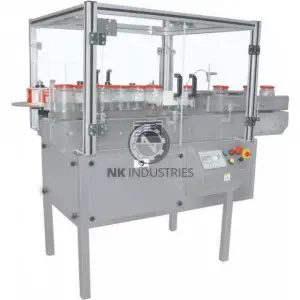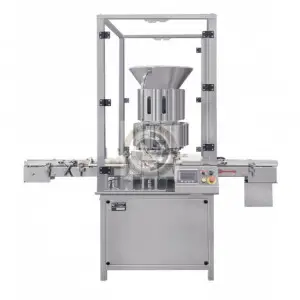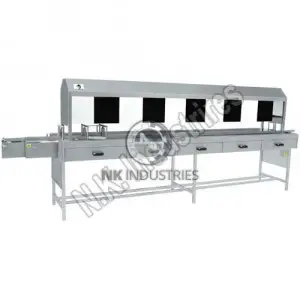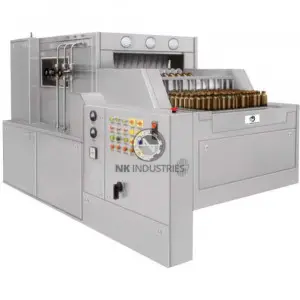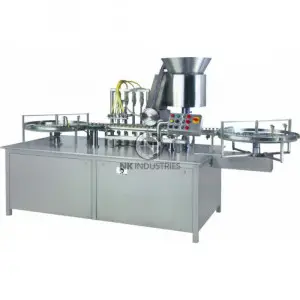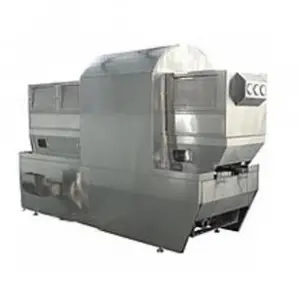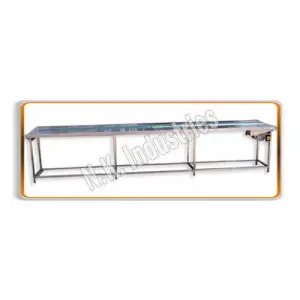N.K Industries, a prominent manufacturer, supplier and exporter of pharmaceutical machinery, is based in Ahmedabad, Gujarat, India. Our reputation for engineering precision and reliability has established us as a leader in the field. Among our distinguished offerings is the Automatic Multi Head Vial Capping Machine, designed to meet the sophisticated needs of aseptic, injectable, and pharmaceutical plants. This advanced equipment is pivotal for ensuring the secure sealing of vials, which is crucial for maintaining the integrity and efficacy of pharmaceutical products.
The Significance of Vial Capping in Pharmaceutical Production
In the pharmaceutical industry, the capping of vials is a critical step in the production process. This process involves sealing vials containing injectable products to protect them from contamination and ensure their effectiveness. A hermetic seal is essential to maintain the drug's stability and prevent any external elements from compromising its quality. Given the importance of this task, the reliability and efficiency of the capping machine are paramount. The Automatic Multi Head Vial Capping Machine by N.K Industries is designed to provide just that—superior performance, precision, and efficiency.
Features and Configurations of the Multi Head Rotary Vial Capping Machine
Our range of Multi Head Rotary Vial Capping Machines is available in various configurations to suit different production needs. The models come in 4-head, 6-head, 8-head, and 12-head versions, each offering specific advantages based on the desired output and production scale. Depending on the configuration, these machines can deliver output rates ranging from 120 vials per minute to 400 vials per minute, ensuring that we can meet the diverse demands of our clients.
1. No Vial - No Capping System
One of the standout features of our Multi Head Rotary Vial Capping Machine is the “No Vial - No Capping” system. This system ensures that capping operations are performed only when a vial is present. The system uses advanced sensors and controls to detect the presence of vials and prevent the application of caps to empty positions. This not only reduces material waste but also enhances operational efficiency by eliminating the need for manual intervention and reducing the risk of errors.
2. Gradual Pressure Sealing (GPS) System
Another significant innovation is the Gradual Pressure Sealing (GPS) system. This technology applies sealing pressure gradually rather than abruptly, which helps in achieving a wrinkle-free and high-quality seal. The GPS system ensures that each cap is applied uniformly, resulting in a perfect hermetic seal that preserves the integrity of the drug. This advanced sealing mechanism is particularly beneficial for maintaining product quality and compliance with industry standards.
3. Compact and Modular Design
Our Multi Head Rotary Vial Capping Machines are designed with a compact and modular configuration. The modular design allows for flexibility and easy integration into existing production lines. This design also facilitates future upgrades and adjustments, making it easier to adapt the machine to evolving production requirements. The compact footprint of the machine ensures that it fits seamlessly into facilities with limited space, optimizing floor space utilization without compromising on performance.
4. CGMP Compliance
Compliance with Current Good Manufacturing Practice (CGMP) standards is essential in the pharmaceutical industry, and our Multi Head Rotary Vial Capping Machines are built to meet these rigorous standards. The machines are designed to minimize particle generation during the capping process, ensuring that the production environment remains clean and contamination-free. This compliance is crucial for maintaining the quality and safety of pharmaceutical products, and our machines are suitable for installation in conventional contamination-controlled environments and under isolators.
5. User-Friendly Operation
Ease of use is a key consideration in the design of our capping machines. The NKCS series features a user-friendly interface that simplifies operation and minimizes the need for extensive training. The intuitive controls and straightforward setup procedures ensure that operators can efficiently manage the machine with minimal effort. Additionally, the machine’s design focuses on reducing maintenance requirements, which helps in minimizing downtime and ensuring smooth, continuous operation.
Detailed Working Sequence of the Multi Head Rotary Vial Capping Machine
Understanding the working sequence of our Multi Head Rotary Vial Capping Machine provides insight into its operational efficiency and precision:
-
Cap Loading: The process begins with loading sufficient caps into a vibratory bowl. The bowl continuously feeds the caps into the cap chute, ensuring a steady supply for the capping process.
-
Vial Feeding: Vials are transported from the in-feed conveyor to the feed worm assembly via a slat conveyor. The feed worm creates spacing between vials before they are moved to the in-feed star wheel.
-
Cap Transfer: As vials reach the in-feed star wheel, the vibratory bowl feeds caps into the chute. A NO-CAP sensor (Fiber Optic Sensor) monitors the cap supply. If the chute runs low on caps, the sensor signals the control panel, and the machine pauses until caps are replenished.
-
Capping Process: The in-feed star wheel indexes each vial, transferring it to the main capping turret. The capping head and turret rotate clockwise, and the cam-operated capping head descends to apply the cap. The sealing chuck threads the cap and secures it onto the vial.
-
Cap Removal: After the capping process is completed, the capping head rises, releasing the sealed vial. At the out-feed star plate, the capped vials are indexed further and transferred to the discharge end of the conveyor.
-
Final Stage: The sealed vials move to the next on-line connected machine via the conveyor. A totalizer (counter) provides information on the total number of capped and sealed vials.

